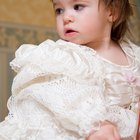
There are some obvious gender differences in children's clothing, such as a tendency to choose different colored clothing for boys and girls, and dresses for girls, opposed to pants for boys. These preferences are known to sociologists and psychologists as "gender stereotyping," and some believe that this impacts the social development of the child.
Color
One of the most obvious gender differences in children's clothing is use of color. Typically, pink clothing is associated with girls, while blue clothing is associated with boys. This color difference tends to be most prominent in babies' clothing, perhaps due to the fact that gender is less apparent in a young baby. Most other colors are seen as gender neutral, but boys are more likely to be dressed in strong colors and girls in pastels.
Skirt Versus Pants
In contemporary times, it is common and acceptable for girls to wear pants and shorts. Conversely, it is not generally acceptable to dress a boy in a skirt or dress. Although girls have been wearing pants for certain work or activities since the 1800s, it did not been commonly acceptable to do so in public until the 1960s.
Historical Differences
Contrary to the above, until around 1940, blue was the common color for girls, as it was seen as daintier. Boys, on the other hand, were dressed in pink, because it is a dilution of the color red, therefore considered to be stronger. In addition, boys were commonly dressed in skirts and dresses up until the age of 6 or 7. It was not until the late 1950s that dresses for baby boys were dropped from the clothing lines in most department stores.
Considerations
The unconscious process of shaping a person to fit in with society's norms and values is known to sociologists as "socialization." Many academics believe that gender stereotyping, via choice of clothes, amongst other aspects, lead to children growing up to fit into traditional gender roles. Others argue that boys used to be dressed in pink and wear dresses, but still grew up with masculine traits and so claim that this theory cannot be correct. There are other points to consider, however, and neither side has been proved or disproved.
Related Articles

Children's Clothing of the 1800s

A Brother's Influence on a Younger ...

Teens Dealing With Jealous Boyfriends

What Experiences Make Men Emotionally ...

Korean vs. American Clothing Sizes for ...

How Absent Fathers Affect Men

How to Deal With a Teenage Boy That Is ...

Shoe Sizes Explained

The History of School Uniform

Children's Clothing From the 1920s

Dating a Man Who Is Feminine

Types of Mother-Daughter Relationships

What Did Teenagers Wear in the '60s?

The Effects of Divorce & Introducing a ...

What Does a Committed Relationship Look ...

The Roles of Older Siblings

What Is the Meaning of Colored Bandanas?

What Does It Mean When Your Boyfriend ...

The Effects of an Absent Mother Figure

Difference Between Men's & Women's ...
References
- Standford Encyclopedia of Philosophy; "Feminist Perspectives on Sex and Gender"; Mari Mikkola; 2008
- Gentle Birth; "Dressing for Sexes"; Jo Paoletti
- The People History: Fashions
- Historical Boys' Clothing: Chronology of the Development of Modern Boys' Clothing Styles
- "Sociology: Exploring the Architecture of Everyday Life"; David M. Newman; 2008
Photo Credits
Jupiterimages/Comstock/Getty Images